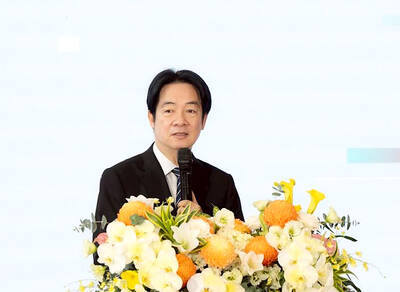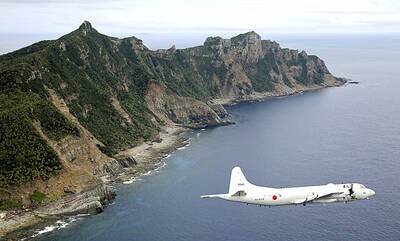The ruling parties of Taiwan and Japan yesterday held their first diplomatic and defense policy discussion, with representatives of Japan’s Liberal Democratic Party (LDP) pledging to support Taiwan’s bid to join the Comprehensive and Progressive Agreement for Trans-Pacific Partnership (CPTPP).
The 90-minute videoconference was attended by Lo Chih-cheng (羅致政) and Tsai Shih-ying (蔡適應) of the Democratic Progressive Party (DPP), with LDP Foreign Affairs division director Masahisa Sato and National Defense division director Taku Otsuka, DPP spokeswoman Hsieh Pei-fen (謝佩芬) said after the meeting.
The Japanese representatives asked Taipei to facilitate an investment by the Taiwanese semiconductor industry — especially Taiwan Semiconductor Manufacturing Co (台積電) — into the Japanese chip industry, Lo said.

Photo courtesy of the Democratic Progressive Party
The LDP representatives also pledged to back Taiwan’s bid to enter the CPTPP, as its participation in the organization is an important goal for Taiwan and regional partners, and would improve Taiwan-Japan relations, Lo said.
Both sides mentioned their concern over the presence of Chinese military vessels and aircraft in Japan’s southwestern and Taiwan’s northeastern sea zones, Tsai said.
Japan said it would invest a significant sum of the next fiscal year’s defense budget to bolster its air superiority in the region, while Taiwan said it would seek to increase its defense and take measures to secure its northeastern front, he said.
Both sides discussed military cooperation, which each said they would forward to their respective defense ministries, he said, adding that he could not comment on the specifics of the dialogue.
They also discussed the US’ resolve to support Taiwan’s defense, Lo added.
The party representatives also agreed to promote coast guard collaborations, Tsai said, adding that just before the meeting started, Sato wrote on Twitter, in Japanese, that “one day, the coast guards of Japan, Taiwan and the US will conduct joint training.”
While the issue of vaccines had not been brought up, Lo said that he had thanked the LDP and the Japanese government for donating vaccines to Taiwan, adding that it would deepen bilateral ties.
The Japan side said that its House of Councilors, the upper house of Japan’s Diet, in June introduced a motion to support Taiwan’s participation in the WHO as an observer.
In a separate comment to reporters after the meeting, Lo said that developing better Taiwan-Japan relations is backed by strong public support.
International affairs are changing, as many nations begin to express doubts about China, and Beijing’s bellicose attitude and military ambitions were among the many issues that led to the meeting, Lo said.
Sato said the dialogue would help inform the Japanese ruling party’s policymaking.
“The Taiwanese side said they had been waiting and hoping for such a dialogue ... [we both] felt it was significant to come up with common goals between the ruling parties that can lead to government policy for both countries,” Sato said.
China last week condemned the talks, saying that Japan should not send the “wrong signals” about Taiwan’s independence.
Lo brushed off China’s objections, saying it was expected.
“Taiwan, as a sovereign and independent country, has the right to promote bilateral and multilateral ties with all countries,” he said.
Additional reporting by Reuters and CNA

MISINFORMATION: The generated content tends to adopt China’s official stance, such as ‘Taiwan is currently governed by the Chinese central government,’ the NSB said Five China-developed artificial intelligence (AI) language models exhibit cybersecurity risks and content biases, an inspection conducted by the National Security Bureau (NSB) showed. The five AI tools are: DeepSeek, Doubao (豆包), Yiyan (文心一言), Tongyi (通義千問) and Yuanbao (騰訊元寶), the bureau said, advising people to remain vigilant to protect personal data privacy and corporate business secrets. The NSB said it, in accordance with the National Intelligence Services Act (國家情報工作法), has reviewed international cybersecurity reports and intelligence, and coordinated with the Ministry of Justice Investigation Bureau and the National Police Agency’s Criminal Investigation Bureau to conduct an inspection of China-made AI language

LIMITS: While China increases military pressure on Taiwan and expands its use of cognitive warfare, it is unwilling to target tech supply chains, the report said US and Taiwan military officials have warned that the Chinese People’s Liberation Army (PLA) could implement a blockade within “a matter of hours” and need only “minimal conversion time” prior to an attack on Taiwan, a report released on Tuesday by the US Senate’s China Economic and Security Review Commission said. “While there is no indication that China is planning an imminent attack, the United States and its allies and partners can no longer assume that a Taiwan contingency is a distant possibility for which they would have ample time to prepare,” it said. The commission made the comments in its annual

‘TROUBLEMAKER’: Most countries believe that it is China — rather than Taiwan — that is undermining regional peace and stability with its coercive tactics, the president said China should restrain itself and refrain from being a troublemaker that sabotages peace and stability in the Indo-Pacific region, President William Lai (賴清德) said yesterday. Lai made the remarks after China Coast Guard vessels sailed into disputed waters off the Senkaku Islands — known as the Diaoyutai Islands (釣魚台) in Taiwan — following a remark Japanese Prime Minister Sanae Takaichi made regarding Taiwan. Takaichi during a parliamentary session on Nov. 7 said that a “Taiwan contingency” involving a Chinese naval blockade could qualify as a “survival-threatening situation” for Japan, and trigger Tokyo’s deployment of its military for defense. Asked about the escalating tensions

DISPUTE: A Chinese official prompted a formal protest from Tokyo by saying that ‘the dirty head that sticks itself out must be cut off,’ after Takaichi’s Taiwan remarks Four armed China Coast Guard vessels yesterday morning sailed through disputed waters controlled by Japan, amid a diplomatic spat following Japanese Prime Minister Sanae Takaichi’s comments on Taiwan. The four ships sailed around the Senkaku Islands — known as the Diaoyutai Islands (釣魚台) to Taiwan, and which Taiwan and China also claim — on Saturday before entering Japanese waters yesterday and left, the Japan Coast Guard said. The China Coast Guard said in a statement that it carried out a “rights enforcement patrol” through the waters and that it was a lawful operation. As of the end of last month,